In the midst of United’s terrible devaluation, the value of American Airlines is more and more apparent. But less-obvious is a little known secret called AA’s Explorer Award Chart.
I’ve written a TON about crazy United award routes and it seems fitting to start doing some AA routes on the first day of United’s devaluation. The first place to start is this mysterious second “Explorer” award chart.
Okay, it’s not really a secret… it’s just not the default option. It’s basically American Airlines giving you a second option for a distance based award chart. The more you fly, the more you pay.
But before we get to the exciting stuff (examples), I’ll do a little explainer: How to figure out prices and what the rules are.
To figure out the price you would figure out the total miles flown (using GCmap), add them up and compare them to the award chart.
Take the number of miles flown and figure out what “zone” it would be priced as. And then below you’ll figure out how many AA miles would be required:
- Zone 1 = 0 to 1,500 flown miles
- Economy Class = 30,000 AA miles
- Business Class = 60,000 AA miles
- First Class = 80,000 AA miles
- Zone 2 = 1,501 to 4,000 flown miles
- Economy Class = 35,000 AA miles
- Business Class = 75,000 AA miles
- First Class = 100,000 AA miles
- Zone 3 = 4,001 to 9,000 flown miles
- Economy Class = 60,000 AA miles
- Business Class = 80,000 AA miles
- First Class = 100,000 AA miles
- Zone 4 = 9,001 to 10,000 flown miles
- Economy Class = 70,000 AA miles
- Business Class = 90,000 AA miles
- First Class = 120,000 AA miles
- Zone 5 = 10,001 to 14,000 flown miles
- Economy Class = 90,000 AA miles
- Business Class = 115,000 AA miles
- First Class = 150,000 AA miles
- Zone 6 = 14,001 to 20,000 flown miles
- Economy Class = 100,000 AA miles
- Business Class = 130,000 AA miles
- First Class = 180,000 AA miles
- Zone 7 = 20,001 to 25,000 flown miles
- Economy Class = 120,000 AA miles
- Business Class = 150,000 AA miles
- First Class = 230,000 AA miles
- Zone 8 = 25,001 to 35,000 flown miles
- Economy Class = 140,000 AA miles
- Business Class = 190,000 AA miles
- First Class = 280,000 AA miles
- Zone 9 = 35,001 to 50,000 flown miles
- Economy Class = 160,000 AA miles
- Business Class = 220,000 AA miles
- First Class = 330,000 AA miles
Tools:
I like to use the OneWorld Route Map to figure out what routes are possible and then map out those possible routes with GCmap to figure out the miles and thus the price based on the award chart above.
Finding award space can be done with these websites: Qantas, British Airways, Expert Flyer, and Award Nexus (I don’t personally use the latter).
Rules:
- Only one open-jaw allowed
- No partners that aren’t in the OneWorld alliance (like Hawaiian or Alaska)
- Max of 16 Segments
- “A person may stopover in each city 1 time. A person, however, may not stopover in the person’s originating or final destination city.”
- Can’t connect through a city more than twice
In many ways the rules are explicitly loose, in that they allow backtracking.
On short haul flights, for the most part, the regular award chart is the best and cheapest option. However on many of the flights, this distance based Explorer award chart would be cheaper. In fact, it’s a great option for many business class routes.
But the best part about these awards are that they allow for unlimited stopovers. Which is pretty darn cool.
So let’s get into it.
US to India
Coming from the east coast this makes a lot of sense.
New York to India via Europe
I’ve run this many ways and it’s always in “zone 6” which is 100,000 miles in economy, 130,000 for business, and 160,000 for first class.
Compare this to AA’s normal prices to Central Asia 90,000 economy, 135,000 business class and 180,000 first class.
This is hugely cheaper on everything but economy. But even in Economy you wouldn’t be able to stopover in Europe with AA’s normal price. And not only can you stopover in Europe, you can pretty much stop as many places as you want as long as you’re under 16 segments total.
For example you could do:
New York to Paris, to Vienna, to Athens, to Amman, to Delhi, to Helsinki, to Warsaw, to Dusseldorf, to Madrid, to New York
JFK-CDG-VIE-ATH-AMM-DEL-HEL-WAW-DUS-MAD-JFK
Or you could perhaps, hop the pacific on the way home.
New York to Paris to Vienna, to Athens, to Amman, to Delhi, to Bangkok, to Hong Kong, to Tokyo, to JFK
JFK-CDG-VIE-ATH-AMM-DEL-BKK-HKG-NRT-JFK
And from the west coast you may be able to get to Delhi for the same price via Asia but can’t really go into SE Asia as much as Japan and China.
Worth it?
Heck yes. If you’re going to Central Asia, especially from the east coast, this is a heck of a deal. And if you like to fly premium cabin, this will actually save miles!
US to Europe
A trip from the east coast of the US to Europe could likely be under 10,000 flown miles, making it 70,000 instead of 60,000 miles with the normal award chart. But given the price of transport in Europe, the 10,000 miles extra is surely worth it for the chance to have unlimited stopovers.
So you could do Chicago to New York, to Dublin, to Vienna, to Paris, to Chicago for 9,754 flown miles and it would cost 70,000 AA miles.
Remember you can stopover at every connection. You could spend a week in Dublin, a week in Vienna (I love Vienna ), a week in Paris and a few days in New York if you wanted to.
Another option…
NYC to Paris, to Vienna, to Zakynthos, to Zurich, to Dusseldorf, to NYC.
Having been to all those places (except Zurich)… this is a pretty cool route that costs only an extra 10,000 AA miles.
West Coast Prices
However, the problem with distance based is that it tends to favor one region. In this case the East Coast. If you were starting in LA on either route it would be a “zone 5” costing 90,000 miles.
Even starting from Dallas or somewhere in the mid-west would be 90,000 miles. However you could probably get more creative with a Dallas route. For example you could do:
Dallas to JFK, to Paris, to Helsinki, to Zurich, to Vienna, to Rome, to Dusseldorf, to Chicago, to Dallas.
Again, you can stop at every point and it would cost 90,000 miles. So it’s an extra 30,000 miles from the standard award.
Premium Cabin
But what I’ve yet to mention is that these routes in business are cheaper with the Explorer award, yet again.
On the normal award chart business class is 100,000 miles and 125,000 for first.
But with the explorer awards, zone 4 (as with the first examples) is 90,000 for business class and 120,000 miles for first. With these east coast examples, you’ll find that choosing the explorer award will save miles if you fly business or first.
Worth it?
Economy? Depends. That many stopovers… would be seriously epic. However, if you’re going from Oct 15 to May 15, then you could do it for 40,000 miles roundtrip with their “off-peak” prices. 40,000 is a lot cheaper than 70k or 90k. In summer however… totally worth it. Trains in Europe are more expensive and longer than you think.
Is Premium cabin worth it? Duh, you’d save miles.
US to SE Asia
This is a huge jump in price but also in value. You can get a trip to Asia for 100,000 miles in economy, or 130,000 in business class.
But you can cover a lot more ground… or air… for the same price.
Vancouver to Tokyo, to Tapei, to Hong Kong, to Bali, to Kuala Lumpur, to Bangkok, to Hong Kong, to Vancouver.
All that for 100,000 miles and a nearly 2,000 flown miles yet to spare.
So compare that to a normal price of 70,000 miles. But also compare how much it would cost to do a roundtrip from Japan to Bali. Sure you could do it in two tickets for a similar price with United. But the AA routing has a few advantages:
- Better award prices for premium cabin
- Better availability with OW airlines (like Cathay and Malaysia than Singapore and Thai) across the Pacific
- Again, unlimited stopovers
Premium Cabin
Southeast Asia and China would normally be 110,000 miles for business or 135,000 miles for first.
With the explorer award for “zone 6”, you can do business class for 130,000 and first for 180,000. So on this one you don’t save miles.
Is it worth it?
It sure is a great deal if you want to see all those places. However, there are really two groups of people that would especially benefit from an explorer award here:
People who live on the west coast, and people with tons of time.
But even then, many of the awards to SE Asia are going to be hard to keep under 20,000 flown miles and in zone 6. So it may be a little idealistic.
US to South America
In general, the same concept applies to South America. If you live in the south, you can get to Chile for 70,000 miles.
Worth it?
If you have a ton of time and are going to Chile and everywhere in between, and are starting from Miami… then probably.
If you’re going to Lima, then that could only be 30,000 to 35,000 miles.
US to South Pacific
Particularly Australia is a far away destination and on the regular award chart it’s 75k/125k/145k (economy/business/first). So let’s compare it to the explorer awards.
Chicago to Hawaii, to Sydney, to Chicago would be 18,500 flown miles and a zone 6.
This means that it would cost 100K/130k/180k.
In terms of business class it’s extremely comparable to the normal price. However, with a regular award, you could get a stopover in Hawaii anyways. And there’s not enough room left to get to New Zealand or even Cairns. So you could add Melbourne but not much else.
Worth it?
Not really. Only if you’re flying business and need another stop near Sydney.
Asia via Europe, which is very common with Star Alliance options like United and US Airways is incredibly expensive with AA Explorer chart, and stopovers aren’t really possible with their other chart. Thus, 120,000 miles for economy, is not really worth it when you can still get it for 70,000 miles with United.
However, again, the huge advantage here is the unlimited stopovers. If this is an around the world trip and will include a ton of stops… go ahead.
Conclusion
Part of me says AA Off-Peak prices are just too darn hard to beat. And then the other part of me loves stopovers. But if you fly premium cabins like Business and First… this is a killer deal on some routes. Particularly to India via Europe. The unlimited stopovers and saving miles is just awesome.


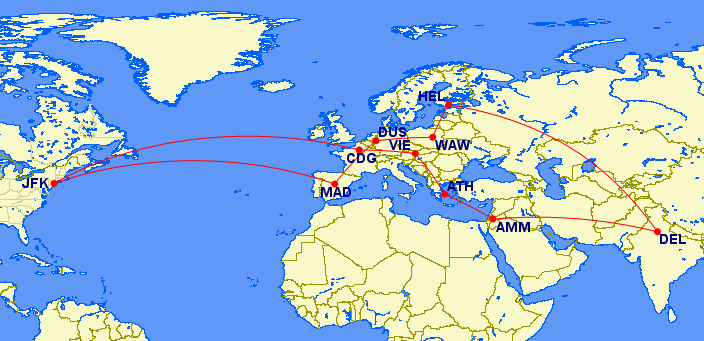
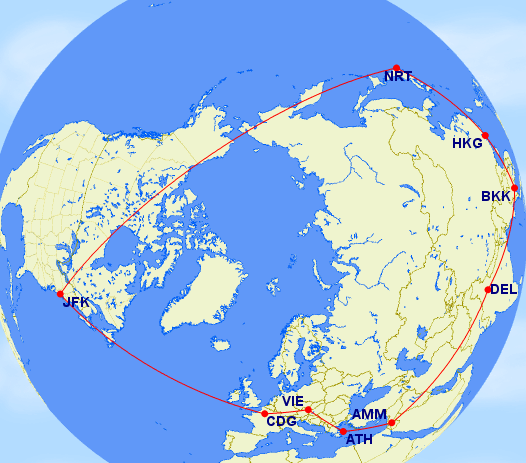
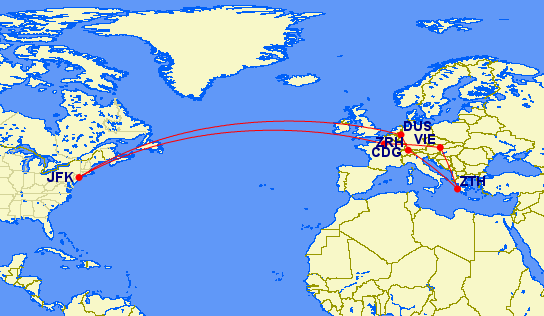
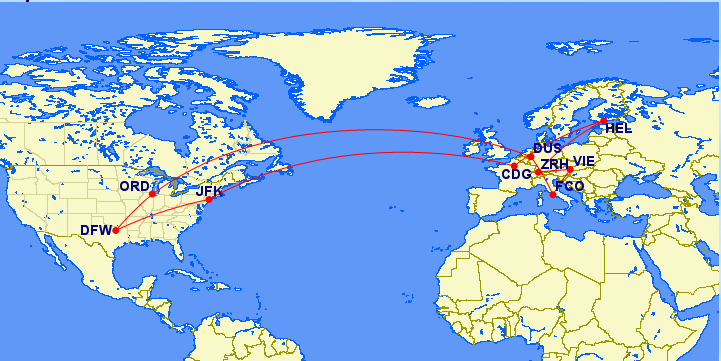
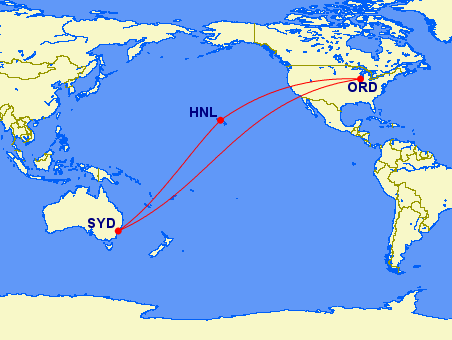




thanks! what’s the easiest way to book? multi – city ticketing through aa.com?
Hey Ross, you’ll want to call AA to book this type of award. Find availability online first though so you can just feed the agent all the flights.
Note that AA.com won’t show all available airlines. For example, Cathay Pacific award space is not displayed on AA.com
Use Qantas.com and BA.com to search for partner award space that doesn’t show up on AA.com
What a timely post! I have been banging my head the last few days trying to cram as much awesomeness as possible and then some into a couple United itineraries in the Pacific and now this. Time to play with South Pacific, Explorer Awards and oneWorld premium cabin availability (*A availability, which is essentially just Air New Zealand SUCKS).
Oh, and just a heads up – your link to the oneWorld interactive map could use a touch-up 🙂
Excellent post! A feature I’m sure you’ll be exploring, because you always do look into all angles of a program, is that at the larger zones you get much greater bang for your buck. Zone 4, for example, is costing you 7 AA miles per maximum flown mile in economy, while Zone 9 costs you only 3.2. The price bands aren’t proportional, and strongly favor the larger Zones. So, as a comparison, you get 20,000 miles for 140k using Zone 4 (spread over two trips in that case), but 50,000 for 160k in Zone 9. Huge difference in value.
So for the serious traveler, it can make sense to combine two or three trips into one Zone 8 or 9 redemption, even returning home in between, rather than doing separate redemptions from the lower zones or from the regular award chart. Business and First redemptions have the similar trait, though the exact numbers are different, of course.
Many people could take three separate round-trips to just about anywhere they want to go (or four or five to well selected destinations) within the 50,000 miles allowed in Zone 9. Each time returning to the U.S. you would need to connect at a different airport and add in a cheap paid or Avios ticket to avoid stopping over at the same place twice.
The issues to consider are finding the available award space each time, staying within the 16-segment limit, and waiting to start booking until 11 months before the final flight.
So, what about starting in Hawaii?
JFK-CDG-VIE-ATH-AMM-DEL-BKK-HKG-NRT-JFK,
for this route, you said cant go into SE Asia as much, Why ?
also instead of Jfk, sub with LAX, how much would the pricing change ?
There’s a very important rule that seems to be missing from your list. You must fly at least TWO oneworld airlines (other than American). In order to book a distance based award your itinerary has to include at least two different OneWorld airlines. For the purposes of airline classifications, Cathay Pacific and their affiliate Dragonair count as one airline. Essentially you can’t use this distance based chart to route just in North America alone on AA.
For the more complex itineraries, there’s a need to clarify the rules on stopovers for this type of award. You’re actually only allowed one stopover and two connections PER CITY. You can connect in a city twice and stop there once. That means you can potentially fly through the same city three times.
Also, worth noting these awards can only be booked by phone as they’re not available for pricing on AA.com
Wait, did I read this right? Unlimited, full-on STOPOVERS?!?!
This is enough to make me want to use AA after swearing I would never use them again after a horrible incident years ago (well, hopefully other airlines instead of AA).
For East Coat-India routes, could they be reversed and be India-East Coast-India routes, with a bunch of other stopovers in between? Or do they have to originate from the US?
I have booked two explorer tickets and they are awesome. I usually book them as my whole year trips.
Each time its for three people in biz.
SFO-HKG-DPS-KUL-SIN-CMB-AMM-IST-LHR-MIA-MCO-LAX-SFO
Total miles 450k.
Sfo,hkg,dps on CX biz
Dps kul sin on MA biz
Sin cmb on CX biz
Amm Ist on RJ biz
Ist Lhr on BA biz
LHR MIA AA biz
Mia lax sfo on AA F
3 people 220k miles each
SJC-ORD-DOH-DXB-AMM-DOH-IAH-DFW-MIA-LGA-DFW-SAN-ORD-AMM-JED-HKG-LAX
Sjc-Ord on AA F
Ord-Doh QR biz
Doh-Dxb QR Y
Dxb-Amm RJ biz
Amm-Doh QR y
Doh-Iah QR biz
Iah-Dfw-Mia-Lga-Dfw-San-Ord AA F
Ord-Amm-Jed RJ biz
Jed-Hkg-Lax on Cx biz
I’m just starting out, but I love a good puzzle.
Your blog is great, some of the easiest to follow complex award booking posts I’ve run across.
Can I use this chart to go from India to Australia via Asia (creating various stopovers in Asia)?
Animesh – with these awards you can essentially do whatever you want, as long as the number of miles fits (and you follow the other rules about not going to the same city, etc. that Drew posted above).
Short answer is yes
Trying to plan a Eurotrip starting in TLV and ending in NYC. The OW Explorer Award seems great, but from what I’ve found so far, there are no direct flights between most of the European countries. LHR, MAD, BER seem to be hubs, but nothing else really connects, so every trip would require going back to one of those 3 as a connection and turning a 2 hour flight into 7+ hours. Am I missing something?
RyanAir it.
Do normal change fees for non-elites still apply? If I wanted to travel for a year and use an Explorer Award, I’d choose the segments when I initially book, but I would likely want to change my segments as I travel. Change fees would still apply, yes?
Once the itinerary is ticketed, you can only change the dates/times of travel. You can’t change airlines and/or cities. There are no fees associated with the changes.
Hello,
I am a newbie. I read the blog and I found it very interesting. However, I am confused about how you actually know where the stop overs could be. When I looked at the flight maps, I seen the departure and arrival city with maybe one layover but I am not sure how you determine the stop overs. Can you please explain this. Remember I am a newbie to your blog. However I travel almost 300 days a year and I want to start getting alot more out of my travel. Thank you
So my question is does the special awad chart based on one way travel or is the miles calculated the total trip miles including the return trip/open jaw?
Just add all your legs and that will give you the Zone where you travel falls. Open jaw distance doesn’t count.
Also a timely article for my family. I had tried to do this for last Christmas, but I was too late. Got an early jump on things this year, and wanted to report that as of 9 pm last night, I am the proud owner of 4 One World Explorer tickets for my family. San Francisco-Seoul-Tokyo-Hong Kong-Singapore-San Francisco. Business class. With fees and taxes it came to $141 each and 130,000 miles. Woo-hoo! So excited. Next it’s time to plan the hotels.
So, if I have 100,000+ US miles and 50,000+ AA miles, will I be able to purchase a Zone 7, business ticket, prior to the two programs merging?
Not at this time. You can’t combine miles YET. Easiest thing to do would be to transfer SPG miles to AA to top off your account (40,000 SPG points = 50,000 AA miles) or to buy 40,000 US Airways miles and do a US-North Asia award in business (90,000 US miles).
So did American’s recent changes just kill this entire program? If so, I’m t’oed…. I made the stretch to get the AA Citi Exec card precisely to have a shot at this…. almost there. And now, in a midnight w/o warning move, BAM, it’s gone.
Is that a fair reading? Hope you’ll at least update your thread, or…. if this is true, just mark it as “history” (along with Vanilla Reload cards at CVS)